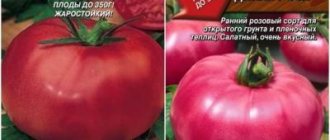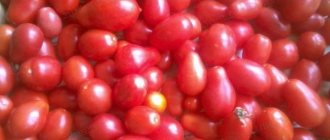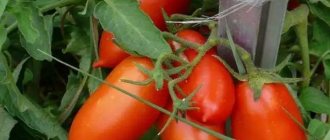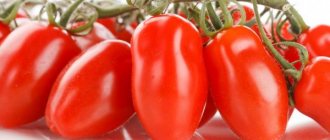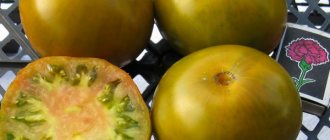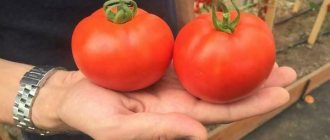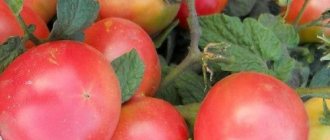Description of the variety
The main things that separate the Rose tomato from others are:
- short ripening time: the tomato reaches biological maturity in 100-110 days;
- low growth of the bush (no more than 60 cm), which allows you to place seedlings even in small greenhouses;
- a simple inflorescence, which is formed in 5-6 racemes;
- the first inflorescence is formed above the 9th leaf, and the second and subsequent ones - above the third;
- abundant leafing;
- short internode;
- the fruits resemble a compressed circle, are multi-chambered, and weigh no more than 200 grams;
- ribbing in the area of the stalk.
Tomato seeds Panekra F1 \ Panekra F1 500 seeds Syngenta
Panekra F1 is an early-ripening hybrid, the fruits are flattened and slightly ribbed, very large, fleshy, weighing 260-300g, have a rich red color and excellent taste, are resistant to cracking when temperature and humidity change.
HYBRID CHARACTERISTICS:
- The growing season from planting seedlings is 58-60 days
- Segment: cultivation in spring-summer and summer-autumn rotation in film greenhouses
FRUIT:
- average weight - 260-280 grams, on the first hands - up to 450 grams
- deep dark red color with shine
- flattened and slightly ribbed
- solid and transportable
- have excellent taste
- resistant to the formation of pigment spots
- Resistant to cracking due to changes in temperature and humidity
PLANT:
- early ripening hybrid (58-60 days after planting seedlings)
- strong, generative type
- powerful root system, grows well in “poor” soils
- stable fruit set
- perfectly maintains balance throughout the season
HARVEST:
- High overall, greater than that of the Tsarin hybrid.
RESISTANCE to:
- strain of tomato mosaic virus (ToMV)
- verticillium (V)
- fusarium wilt of tomato (Fol 1-2)
- cladosporiosis - brown spot (Ff 1-5)
- fusarium root rot (For)
- nematode (M)
ADDITIONAL INFORMATION:
- A new tall hybrid that combines the high quality of really large fleshy fruits and early harvest.
- The hybrid forms from 8 to 15 clusters, depending on the design of the greenhouse. Consistently sets 4-6 fruits in a cluster, while maintaining a standard mass.
- Despite their size, they are resistant to cracking due to changes in temperature and humidity. This is a very important indicator when growing large-fruited tomatoes in the second rotation.
- Panekra F1 is stable in bulk, which allows you to obtain 95% of standard products throughout the entire growing period, and most importantly, a high overall yield by the end of the growing season.
- The hybrid exhibits a high degree of fruit set during the hot period of the second rotation, and strong plants maintain excellent balance throughout the entire growing period.
- Panekra F1 has a very strong root system, which allows the hybrid to be grown on poor soils and in monoculture.
- The hybrid successfully passed production tests in 2012 - both in the first and second rotations, demonstrating high productivity and a complex of resistance, and was highly appreciated by farmers.
- Panekra F1 deserves the attention of growers who want to grow really large tomatoes.
Landing
You can start sowing seedlings in March.
Before you start planting, you must carefully select seeds suitable for cultivation. For this:
- pay attention to the expiration date of the seeds (usually it is indicated on the back of the package and should not be more than 2 years);
- choose only a trusted manufacturer in a certified store (this will help you avoid purchasing low-quality products);
- pour the seeds, for example, into a cut glass and fill it with water;
- add a teaspoon of salt there without a lump and mix well;
- after 30 minutes, all low-quality seeds will certainly float to the surface;
- get rid of them, and place those remaining at the bottom on damp gauze;
- leave it for a few more days.
MANDATORY! Check the moisture content of the gauze daily and wet it as necessary. This will help the seeds sprout faster. You can also use growth stimulants, then the seeds will germinate faster by a few days.
Once the seeds open and you notice green shoots on their surface, you can begin replanting into pots.
INTERESTING! Experts advise paying attention to peat containers: they are environmentally friendly and can serve in the future as fertilizer. And due to the fact that you can move it into the ground with it, it will not damage the root system of the seedlings.
The seeds should not be immersed deeply - the maximum depth is 1 cm. The distance between the grooves is no more than 2. To create greenhouse conditions, cover the container with film. Check soil moisture daily. As soon as the first leaves appear, remove the film immediately, otherwise the seedlings may burn.
Keep watering it and wait for 3-4 leaves to appear. As soon as they are fully formed, begin to transplant them into different pots. When replanting, place the stem about a third into the ground (the guideline is the distance between the leaves and the ground is no more than 1 cm). This technique can strengthen the roots and prevent the bush from stretching out.
As the seedlings form:
- ensure the temperature is not lower than + 25 degrees;
- Using table lamps or special greenhouse lamps (phytolamps), provide the seedlings with at least 14 hours of daylight per day.
ATTENTION! The lamps should be positioned no higher than 15 cm, otherwise this may lead to the seedlings being stretched out and development to be suspended;
- do not let the soil dry out and do not try to over-moisten it;
- feed the sprouts with fertilizers, such as complex fertilizers;
- harden off daily by taking the pots outside or airing them.
After 15 days, feed with nitroammophoska. To do this, dissolve half a spoon of fertilizer in five liters of water. For one seedling no more than 100 ml. After 14 days, repeat the procedure.
If, after hardening, the leaves suddenly turn yellow, and under normal conditions they wrinkle, this directly indicates a lack of calcium. To replenish it, it is necessary to fertilize the bush with potassium monophosphate. This is easy to do: just scatter a small amount near the stem, first retreating a few centimeters, then loosen and water the tomato with Rose.
When the lower part of the leaf turns purple, the bush does not have enough phosphorus. To eliminate it, feed it with superphosphate.
Features of cultivation
Indeterminate varieties and hybrids of tomatoes are grown only by seedlings.
Growing seedlings
Indeterminate tomato seedlings are ready for planting approximately 2 months after germination. Usually the seeds are sown in mid-March. The Syngenta company produces tomato seeds already treated with disinfectants and growth stimulants. They don’t even need to be soaked before sowing. Sow dry seeds in soil consisting of peat, humus and turf soil, taken in equal parts. For each ten-liter bucket of the mixture add 3 teaspoons of complete mineral fertilizer and ½ cup of ash. The soil is moistened.
For the initial cultivation of seedlings, a plastic container about 10 cm high is well suited. You can sow the seeds directly into individual cassettes or cups.
Important! Friendly germination of seeds is possible only in warm soil. Its temperature should not be less than 25 degrees.
To preserve heat, the container with the sown seeds is placed in a plastic bag.
After germination, the container is transferred to a bright place. The temperature is reduced to 20 degrees during the day and 14 at night for several days. Then the optimal daytime temperature for seedlings is about 23 degrees.
If the tomatoes are sown in a container, when 2 true leaves appear, they are picked into separate cassettes or cups. At this time, a 200-gram container is enough for young sprouts. But after 3 weeks you will have to transfer it into a larger container - about 1 liter in volume. The same procedure is carried out with plants growing in separate cups.
Water the seedlings as the surface layer of soil dries. Feed Panekra F1 tomatoes once every 10 days with a weak solution of complete mineral fertilizer.
Attention! If seedlings are grown in violation of the conditions of detention, they will inevitably stretch out.
The longer the internodes of indeterminate tomatoes, the fewer clusters they will eventually be able to set.
Transplanting
This is carried out when the soil in the greenhouse has a temperature of at least 15 degrees. The greenhouse should be disinfected in the fall, and the soil should be prepared and filled with humus, phosphorus and potassium fertilizers.
Indeterminate tomatoes of the Panekra F1 hybrid are placed at a distance of 60 cm in the row and the same amount between the rows. It is very useful to mulch the planted plants with a layer of mulching material 10 cm thick. Hay, straw, pine litter or wood chips are suitable. If you decide to use fresh sawdust, they need to be moistened with a solution of ammonium nitrate, otherwise there will be large losses of nitrogen. Rotted sawdust does not need this procedure.
Important! Mulch will not only retain moisture in the soil, but also save it from overheating in hot weather.
Hybrid care
Panekra F1 is an intensive type tomato. In order for it to fully realize its yield potential, it needs to be watered and fed on time.
There is no rain in the greenhouse, so maintaining optimal soil moisture is the responsibility of the gardener. The most convenient way to do this is with drip irrigation. It will give the plants the necessary moisture, and the air in the greenhouse will remain dry. The tomato leaves will also be dry. This means that the risk of developing diseases caused by fungal microorganisms is minimal.
Feed Panekra F1 tomatoes once a decade with a solution of complete mineral fertilizer with microelements.
Advice! During flowering and fruit formation, increase the proportion of potassium in the fertilizer mixture.
This indeterminate hybrid tends to form many stepsons, and therefore requires mandatory formation. It needs to be grown in 1 stem, only in the southern regions it is possible to grow it in 2 stems, but then the plants need to be planted less often, otherwise the fruits will become smaller. Stepchildren are removed weekly, preventing them from depleting the plant.
More information about growing tomatoes in a greenhouse can be seen in the video:
If you need a tomato with high yield and excellent taste of the fruit, choose Panekra F1. He won't let you down.
Growing
ATTENTION! In the fall, at the end of the sowing season, be sure to enrich the soil with complex fertilizers. This will help increase the yield several times. And the bed should be on the sunny and windless side
.
You can transplant it into open ground without fear in June, but since the variety is not afraid of frost, you can start planting it 1-2 months earlier as an experiment. The experiment will be especially successful for those who grow Tomato Rose in a greenhouse.
The most common and convenient scheme is where:
- between rows the distance is no more than 40 cm;
- between holes - no more than 30 cm;
- passage between rows – 70 cm.
This way the bushes will grow freely, and make the process of watering and processing tomatoes easier for yourself. Variety care
Diseases and pests
Giving a description and presentation of the Panekra F1 hybrid, it is impossible not to note its uniform stability to a number of diseases. He is not affected:
- strain of tomato mosaic virus;
- verticillium;
- Fusarium wilt of tomato;
- cladosporiosis - brown spotting;
- fusarium rottenness of roots;
- nematode.
Panekra F1 - greenhouse tomato. Farmers grow it in heated greenhouses; for this reason, seeds for seedlings are sown very early and grown with lighting so that the seedlings can be planted in March. Many gardeners do not have heated greenhouses. They grow a Panekra F1 tomato in an ordinary greenhouse.
To obtain a guaranteed high-quality harvest, you must:
- Feed tomatoes no more than 2-3 times a month.
Both complex fertilizers and nitrogen and potassium fertilizers are perfect for this. When purchasing, pay attention to the composition: it is worth purchasing fertilizers with the maximum content of phosphorus and potassium. Feeding is necessary at the stage of bush formation (discussed above), as well as at the stage of budding and formation of the vegetable. Do not forget to feed the seedlings a week after transplanting into the ground.
- Loosen the soil
An important and necessary procedure, especially after applying fertilizer. It helps not only to saturate the roots with air, but also ensures the best penetration of beneficial microelements and minerals into the bush. Loosening is also required after watering.
- Remove weeds
They can not only completely hide tomatoes from the sun, but also cause more serious and irreparable damage. Always keep your garden beds clean.
- Water
It seemed that it could be even simpler, but it is errors in watering that lead to the development of fungal diseases and death of the root system. Water strictly at the root, water should not get on the leaves. Ideal time: early morning before sunrise and late evening after sunset.
- Ventilate the greenhouse
It is extremely necessary to ventilate the greenhouse and monitor the temperature inside, because high humidity not only leads to the appearance of fungus, but can also completely destroy the bushes.
Characteristics of Panekra tomato
Panekra tomatoes ripen very quickly - already 2 months after the seedlings emerge, they become technically ripe. Green fruits can be left to ripen on a branch or placed in a dark, cool place. The first harvest can be harvested as early as mid-May.
Panekra tomato yield and fruiting
The productivity of tomatoes is exceptionally high - up to 25-30 kg are harvested from 1 bush over the entire season, which is incomparably high compared to most domestic varieties. Thanks to this, such tomatoes can be grown not only in household plots, but also in farms: their production is profitable.
| Conditions | Greenhouse |
| From 1 bush, kg | 25-30 |
| From 1 m2, kg* | 50-60 |
*It is recommended to place 2 Panekra tomato bushes per 1 m2; Moreover, a maximum of 5 plants can be planted in such an area. Sparse planting will allow you to achieve the highest yield.
To get the greatest harvest, you should adhere to the basic rules for growing this crop:
- Regular watering - 2-3 times a week, and every day during drought.
- Fertilizer application according to the standard scheme (Panekra tomatoes bear fruit well even on depleted soil).
- Ventilation of the greenhouse (especially after watering, in hot weather).
- Tying to a support (when the bushes reach 30-40 cm).
- The formation of a bush is in most regions with 1 stem, and in the southern regions - with 2.
- Regular pinching - side shoots are removed weekly.
Area of application of fruits
Tomatoes are mainly used fresh in various dishes, for the following preparations:
- salads;
- cold snacks;
- vegetable slices;
- homemade ketchups;
- soups;
- sauces;
- lecho;
- vegetable caviar.
Such fruits are not suitable for canning as a whole, since they are too large.
Important! According to the classification, Panekra tomatoes belong to beef tomatoes. These are large, fleshy and juicy fruits, intended mainly for fresh consumption.
Resistance to diseases and pests
The immunity of the Panekra hybrid is very good. Tomatoes rarely suffer from fungal, viral and bacterial infections. As a preventive measure, it is recommended to treat the seedlings once with a fungicide before transplanting into the greenhouse, and also monitor the bushes during cultivation. If insect pests are found on them, it is recommended to spray the plants with insecticides or homemade solutions (according to folk recipes).
Resistance to diseases and adverse conditions
The variety is resistant to many nightshade diseases, for example: tomato mosaic, verticillium and fusarium blight, cladosporiosis, bacterial wilt, blossom end and root rot.
But it is prone to late blight. This is a fungal disease. There are many reasons for its development: high humidity, low temperature, fog, the spread of fungus from the affected tops, frequent rains.
Signs:
- dark spots of a brown or grayish tint;
- rapid spread of stains;
- fluffy whitish coating;
- ugly deformation of fruits;
- active rotting of tomatoes, which is accompanied by an unpleasant odor.
How to fight?
Completely remove the bushes and burn them. The fungus spreads too quickly and even chemicals cannot cope with it (only slow it down). As a preventative measure, use fungicides and copper-containing preparations.
The Rose tomato suffers from aphids. Aphids, secreting liquid, attract ants, which only worsen the situation. How to fight? Buy larvae of beneficial insects (ladybugs, flies) at the store - they, as a rule, quickly cope with this pest. Bushes can be treated with chemicals, but only until the buds appear (“Aktara” does a good job of this task).
Thrips prevent seedlings from developing. These are pests no larger than 2 mm in size. They have a black elongated body, a striped belly and five pairs of legs. Their larvae are white or translucent.
Signs:
- multiplicity;
- increased activity;
- drink juices from tomato leaves;
- curvature of the tops and drying out;
- holes in leaves and fruits;
- the dying off of greenery and its further coloration in yellow.
They transmit diseases from different plants.
How to fight? Actively treat with insecticides. ATTENTION! Apply before fruit appears.
This variety is not afraid of unfavorable conditions, such as heat or sudden temperature changes.
Pest and disease control
Although the variety is resistant to infections and pests, experienced gardeners advise taking preventive measures against viral and fungal diseases, because tomatoes grow in greenhouses. High humidity increases the likelihood of crop damage. You can spray with Bordeaux mixture or copper sulfate.
Biologically based insecticides will help against all pests. Even if insects have accumulated on tomatoes in large quantities, treatment will get rid of them in a couple of hours. In addition, the drug is heat stable and does not lose its properties even at a temperature of 35°C.
Important! Biological pest control does not harm the environment, as well as the health of people and pets.
